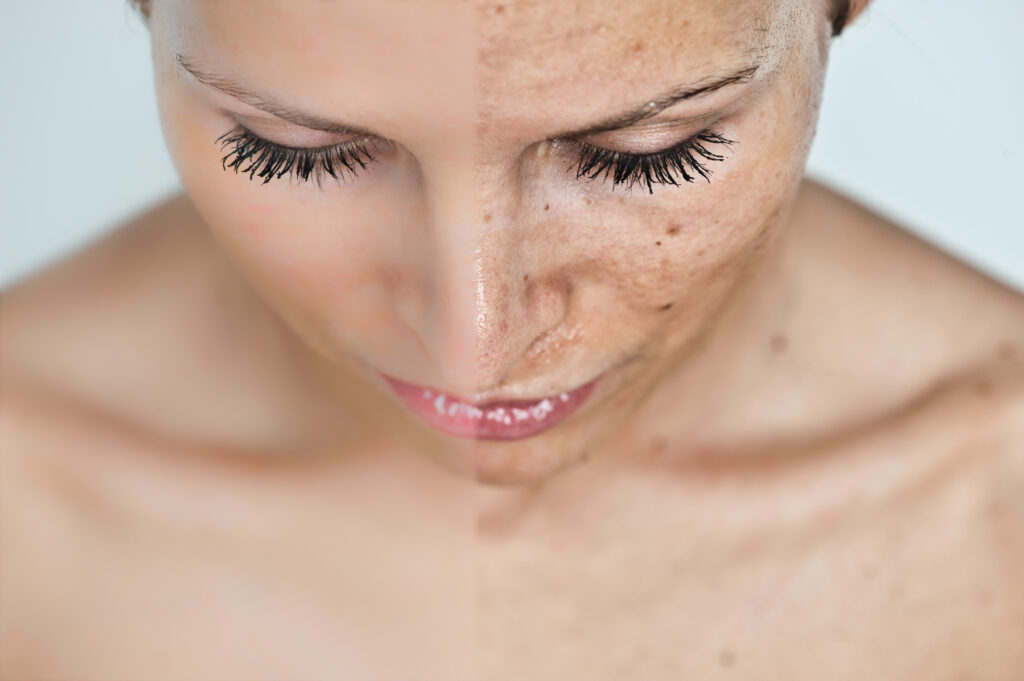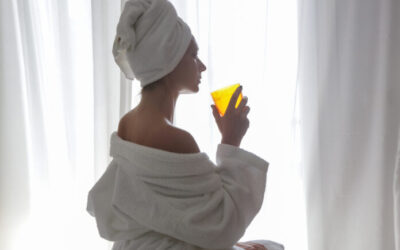Natural Ways to Protect Your Skin from Photoaging
Spending time in the sun has big benefits, such as increasing the amount of vitamin D your body produces. Yet that time in the sun can also lead to damage and accelerate signs of aging. There’s a lot to be said for loving the skin you’re in, including any wrinkles, spots, and other signs of the passage of time. But that doesn’t mean you can’t protect skin from photoaging.
What Is Photoaging?
Photoaging is the term that applies to all skin damage caused by exposure to UVA and UVB rays over time. Because photoaging affects cells in the dermis, which is at a deeper level, it can take years before we can see the damage. As we get older, the skin changes and loses elasticity, which can lead to sagging skin, fine lines and wrinkles, spider veins, uneven darker spots (aka age spots), or uneven color and texture.
Skin that sees the most sun exposure is the most likely to have evidence of photoaging. So, it’s most visible on the face and neck, the top of the hands, the upper chest, and the arms.
While all of us will see signs of aging as the years go by, spending time in the sun can increase those signs and can also produce DNA changes that may increase the risk of skin cancer.
Photoaging is more common for people who:
- Have light or fair skin
- Have lighter-colored eyes (blue or green) and lighter-colored hair (blond, red, or golden brown)
- Burn before tanning
- Have freckles or moles
- Live in sunny locations or at high altitudes
- Spend weekdays mostly indoors and weekends mostly outside
- Actively try to tan, especially when children or teenagers
- Have a history of skin cancer, especially melanoma
Yet photodamage can occur even for those with dark skin who aren’t as likely to sunburn. All that’s needed is excess exposure to UV radiation to damage the skin. You also have an increased risk if you have certain autoimmune diseases, are an organ recipient, or take some medications (including corticosteroids or those to treat arthritis, asthma, or that make your skin more sensitive to sunlight).
How to Protect Skin from Photoaging
Once the damage has been done, it can’t be completely undone. So, it’s important to protect the skin from the damaging effects of photoaging, preferably before it starts. How?
- If possible, avoid going out in the direct sun (unprotected) between the hours of 10 a.m. and 2 p.m.
- Apply sunscreen with a 30 or higher SPF daily before you head outdoors, even when there’s cloud cover.
- Reapply sunscreen every two hours and more often if you’re enjoying water sports or sweating a lot.
- Wear UV protective clothing, including a sun hat, long-sleeved shirt, and pants to prevent burning if you’ll be outside for an extended period of time.
How to Rejuvenate the Skin after Photoaging
Most of us associate fun with the sun, and we enjoy our time spent in nature. Unfortunately, especially when we’re younger, applying sunscreen or covering up can be an afterthought. We may only use it after the skin starts to feel hot and dry or to look a little pink (or red).
In addition, most (~75%) sun exposure is incidental. That is, it occurs when we’re running errands, heading to work or school, and doing everyday activities. And the future damage isn’t even recognized, especially as the damage is inflicted in our teens or early 20s but doesn’t become visible until decades later.
While it’s impossible to turn back the clock and undo all the damage, fortunately, there are some ways to help rejuvenate skin to some degree. Common options include:
- Consuming a nutrient-rich diet that provides plenty of vitamin C and other antioxidants. Antioxidants, for instance, have been shown to help decrease UV damage, support collagen levels in the body, and slow the signs of skin aging. Vitamin C is needed for the body to produce collagen, which promotes skin tone and elasticity. Beta-carotene is another skin-healthy nutrient that may help increase skin elasticity and restore collagen.
Fill your plate with berries, pomegranate, guava, watermelon, cucumber, tomatoes, carrots, leafy greens, sweet potatoes, broccoli, and other nutrient-rich fruits and vegetables to help protect skin from sun damage and promote repair.
- Eating more fatty fish (or taking fish oil supplements), which provides the fatty acids (like EPA) that are essential to hydrating the skin. Some research even suggests consuming four grams of EPA per day can help decrease the risk of sunburn and protect the skin cells from sun damage.
- Adding collagen to your diet. Collagen is vital for healthy digestion, joint health, and more youthful-looking skin. Research suggests using collagen helps increase skin hydration and promote skin elasticity. It may also protect against UV radiation. Collagen can be found in foods like bone broth. However, to get sufficient amounts, supplementation is often recommended. And for even greater benefits, collagen can be combined with antioxidant-rich foods.
- Staying hydrated. Unfortunately, few of us drink enough water to fully hydrate. Water is needed to flush out toxins and help the skin regenerate. Depending on your location (climate), the time of year, health status, and more, the Institute of Medicine suggests getting 91 to 125 ounces (or up to 15.5 cups) of fluid every day.
That’s not just the water you sip on but water found in foods and other drinks. Just remember that drinks that contain alcohol, caffeine, or sugar can dehydrate the body. - Using natural products containing alpha-hydroxy acid (AHA), which helps exfoliate dead skin cells and promote skin cell turnover and rejuvenation for fresher, glowing skin. AHAs, including lactic acid, glycolic acid, malic acid, citric acid, and tartaric acid, naturally occur in fruits, sugar, and milk. They’ve been found to smooth skin, reduce the appearance of dark spots and fine lines, help decrease scarring, and even help fight acne when applied topically.
Various concentrations of AHAs are available in cleansers, toners, serums, peels, and moisturizers designed to improve the look of your skin. Some can be left on the skin as a daily moisturizer. Others are meant to be used and washed off after a short time. So, make sure you follow the manufacturer’s directions and test them on a small area of your skin to ensure your skin doesn’t negatively react. - Exfoliating to improve skin texture. One of the symptoms of photoaging is dry, ashy, flaky, bumpy, or rough skin. It’s often due to dead skin cells on the surface. One of the best ways to encourage skin turnover (and increase circulation) is to gently exfoliate it. You can use mechanical options like loofahs, brushes, or sponges. Or choose exfoliating products that contain physical exfoliants like salt, sugar, coffee grounds, or walnut or apricot granules.
Exfoliants help remove dead skin, unclog pores, improve some skin conditions, and make the skin look more radiant. However, it’s a good idea to avoid using them more than a couple of times per week as they can be abrasive and irritating, which can damage the skin’s moisture barrier. Exfoliants also should be avoided on damaged skin.
- Taking advantage of plant-based skincare alternatives to some of the harsher skin treatments. For instance, Bakuchiol may help reduce the appearance of fine lines and wrinkles without causing irritation common with chemicals like prescription-strength Retinol. (Retinol is derived from vitamin A, and while effective, it is also known to inflame skin and increase sun sensitivity.) Bakuchiol may also help protect the skin from further damage as it promotes improved elasticity for younger-looking skin.
Snow algae is another antioxidant-rich botanical ingredient shown to help reveal your skin’s natural radiance as it helps slow the skin’s aging to help improve skin tone and texture. Snow algae has been found to help strengthen the skin’s natural barrier and boost hydration and collagen production when applied topically.
These natural ingredients found in quality skin lotions and serums may be especially beneficial for locking in moisture for sensitive skin.
- Smooth in antioxidants like aloe vera, which has been shown to replenish and nourish the skin, soothe sunburn, and even help reduce the discomfort of sun damage and promote wound healing.
- Getting your beauty sleep. Anyone who’s ever had a rough night of sleep knows their skin pays the price. You may look in the mirror and see dark undereye circles, droopy eyelids, and dull, dry skin. Yikes. Prioritizing sleep helps reduce the appearance of fine lines, prevent sagging, and make skin look brighter. That’s because the skin cells use these hours to repair and renew, generate collagen, balance hormones, and promote blood supply.
Once you prioritize sleep (between 7 and 9 hours every night), you’ll start seeing the results as the skin sheds damaged cell and makes room for new ones. This is also why skincare products may be especially useful when applied before bed.
Protect Skin from Photoaging Takeaway
Sunshine shouldn’t be completely shunned. Spending time in the sun has been found to boost mood and energy levels, increase vitamin D production, and promote healthy sleep. Plus, being outside is pleasurable, whether you’re going for a walk or hike, gardening, or just taking in a deep breath.
That said, it is important to find the right balance for you and your skin to soak up all the benefits of the sun without increasing the risks. Taking care of your skin at the first signs of damage can help protect skin from photoaging so you can continue to love the skin you’re in.



